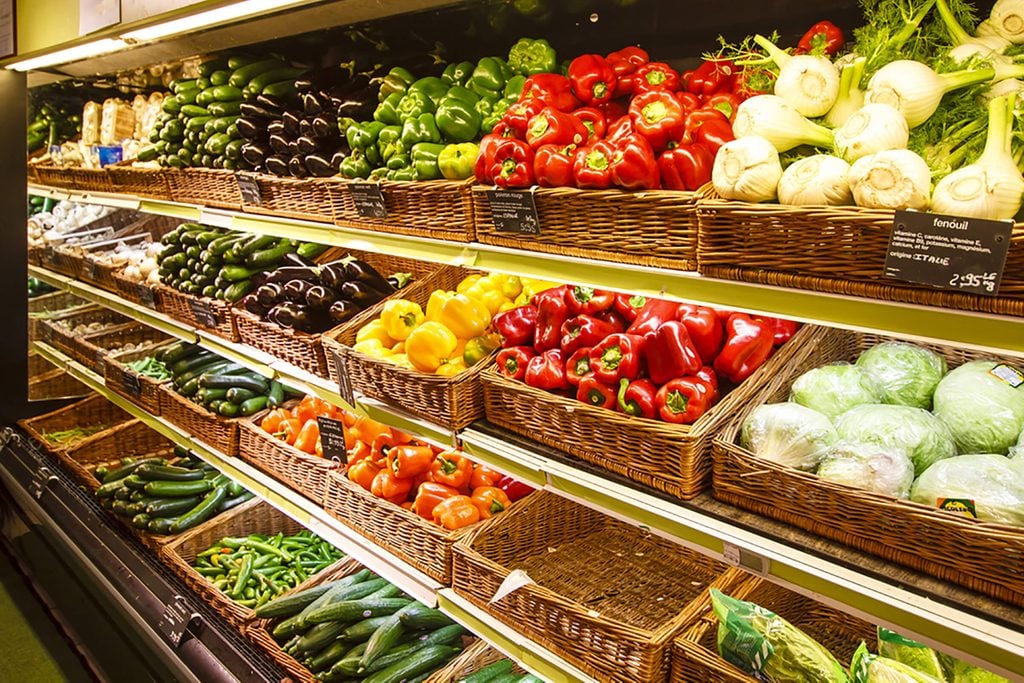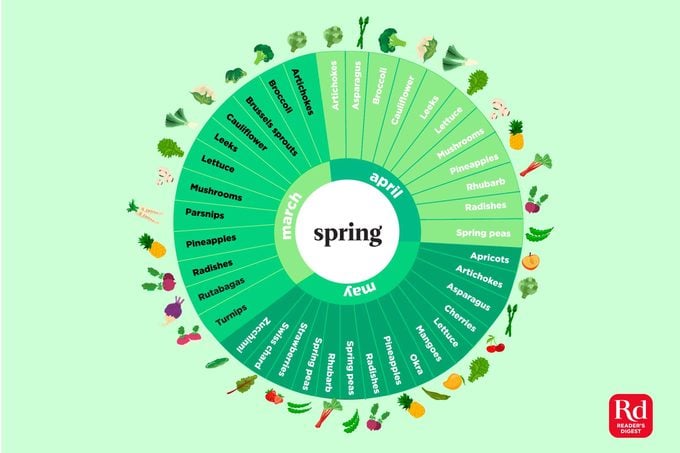These Infographics Show the Fruits and Vegetables in Season Every Month of the Year
Updated: Jun. 06, 2019

Plan to purchase your fruits and vegetables during their peak seasons, and you'll not only enjoy them more, you'll save money while maximizing nutrition.
Think of the experience of a perfectly ripe, juicy summer tomato—rich red color, perfect consistency, bursting with flavor. Buying in season makes all fruits and vegetables more enjoyable—and that’s not the only benefit, according to NYC-based registered dietitian Lisa Hayim. When you purchase produce at peak season, you get more natural nutrients, she says. “Because seasonal fruits and vegetables don’t undergo lengthy transit times to get from farm to your kitchen, these integral vitamins and minerals are more likely to be preserved by the time you’re ready to eat your produce,” she says. In fact, the Cleveland Clinic reports that spinach can provide up to three times more vitamin C when consumed in season—September through October.
You’ll also save money: Shorter travel times for your produce means lower shipping costs, which lowers the grocer’s price and those savings get passed on to you at checkout. There’s also the law of supply and demand, says Los Angeles-based registered dietitian Lindsey Pine. “When fruits and veggies are in season, the farmers will most likely have an abundance of the crop and prices will go down.” For example, GAIAM reports that out-of-season basil runs $3 per half ounce; in season, it’s just $1 to $2.
If you’re looking for the freshest of the fresh, your local farmer’s market is a great place to start. Before you go, check out the six giveaways the produce at the farmers market isn’t fresh or local. And if you’re short on shopping time, join a CSA (community-supported agriculture association) for fresh, picked-that-morning produce sourced directly from a local farm. And when you’re shopping at the grocery store, you can buy in season with this guide to ensure you get the biggest nutritional bang for your buck. Don’t miss the best farmers market in each state.

December
- Broccoli
- Brussels sprouts
- Cabbage
- Cauliflower
- Grapefruit
- Kale
- Leeks
- Mushrooms
- Oranges
- Papayas
- Parsnips
- Pears
- Pomegranates
- Rutabagas
- Sweet potatoes
- Tangelos
- Tangerines
- Turnips
January
- Broccoli
- Brussels sprouts
- Cabbage
- Cauliflower
- Grapefruit
- Kale
- Leeks
- Lemons
- Oranges
- Parsnips
- Rutabagas
- Tangelos
- Tangerines
- Turnips
February
- Broccoli
- Brussels sprouts
- Cabbage
- Cauliflower
- Grapefruit
- Kale
- Leeks
- Lemons
- Oranges
- Parsnips
- Rutabagas
- Tangelos
- Tangerines
- Turnips

March
- Artichokes
- Broccoli
- Brussels sprouts
- Cauliflower
- Leeks
- Lettuce
- Mushrooms
- Parsnips
- Pineapples
- Radishes
- Rutabagas
- Turnips
April
- Artichokes
- Asparagus
- Broccoli
- Cauliflower
- Leeks
- Lettuce
- Mushrooms
- Pineapples
- Radishes
- Rhubarb
- Spring peas
May
- Apricots
- Artichokes
- Asparagus
- Cherries
- Lettuce
- Mangoes
- Okra
- Pineapples
- Radishes
- Rhubarb
- Spring peas
- Strawberries
- Swiss chard
- Zucchini

June
- Apricots
- Blueberries
- Cantaloupe
- Cherries
- Corn
- Kiwi
- Lettuce
- Mangoes
- Peaches
- Strawberries
- Swiss chard
- Watermelon
- Zucchini
July
- Apricots
- Blackberries
- Blueberries
- Cantaloupe
- Corn
- Cucumbers
- Green beans
- Kiwi
- Kohlrabi
- Lettuce
- Mangoes
- Okra
- Peaches
- Peppers
- Plums
- Raspberries
- Strawberries
- Summer squash
- Swiss chard
- Tomatoes
- Watermelon
- Zucchini
August
- Acorn squash
- Apples
- Apricots
- Blueberries
- Butternut squash
- Cantaloupe
- Corn
- Cucumbers
- Eggplant
- Figs
- Green beans
- Kiwi
- Kohlrabi
- Lettuce
- Mangoes
- Okra
- Peaches
- Peppers
- Plums
- Raspberries
- Strawberries
- Summer squash
- Swiss chard
- Tomatoes
- Watermelon
- Winter squash
- Zucchini

September
- Acorn squash
- Apples
- Beets
- Butternut squash
- Cantaloupe
- Cauliflower
- Eggplant
- Figs
- Grapes
- Green beans
- Lettuce
- Mangoes
- Mushrooms
- Okra
- Peppers
- Persimmons
- Pomegranates
- Pumpkins
- Spinach
- Sweet potatoes
- Swiss chard
- Tomatoes
October
- Acorn squash
- Apples
- Beets
- Broccoli
- Brussels sprouts
- Butternut squash
- Cabbage
- Cauliflower
- Cranberries
- Grapes
- Leeks
- Lettuce
- Mushrooms
- Parsnips
- Persimmons
- Pomegranates
- Pumpkins
- Rutabagas
- Spinach
- Sweet potatoes
- Swiss chard
- Turnips
- Winter squash
November
- Beets
- Broccoli
- Brussels sprouts
- Cabbage
- Cauliflower
- Cranberries
- Leeks
- Mushrooms
- Oranges
- Parsnips
- Pears
- Persimmons
- Pomegranates
- Pumpkins
- Rutabagas
- Spinach
- Sweet potatoes
- Tangerines
- Turnips
- Winter squash